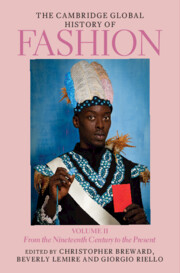Book contents
- The Cambridge Global History of Fashion
- The Cambridge Global History of Fashion
- The Cambridge Global History of Fashion
- Copyright page
- Contents for Volume II
- Figures for Volume II
- Maps for Volume II
- Table for Volume II
- Contributors for Volume II
- Preface
- Part IV Fashion, Modernism, and Modernity
- Part V Fashion, Colonialism, and Post-Colonialism
- Part VI Fashion Systems and Globalization
- 35 Manufacturing Fashion in the Post-War Period
- 36 Producing and Predicting Fashion in Twentieth-Century America and Europe
- 37 The Origins and Development of Haute Couture, 1858 to Now
- 38 Couture, Prêt-à-Porter, and Fast Fashion since 1945
- 39 Casualwear and Its Birth in Japan
- 40 Fashion and Globalization
- 41 Streetscape, Shop Window, Museum Vitrine
- 42 Fashion and Global Sustainability
- Index
- References
35 - Manufacturing Fashion in the Post-War Period
from Part VI - Fashion Systems and Globalization
Published online by Cambridge University Press: 04 August 2023
- The Cambridge Global History of Fashion
- The Cambridge Global History of Fashion
- The Cambridge Global History of Fashion
- Copyright page
- Contents for Volume II
- Figures for Volume II
- Maps for Volume II
- Table for Volume II
- Contributors for Volume II
- Preface
- Part IV Fashion, Modernism, and Modernity
- Part V Fashion, Colonialism, and Post-Colonialism
- Part VI Fashion Systems and Globalization
- 35 Manufacturing Fashion in the Post-War Period
- 36 Producing and Predicting Fashion in Twentieth-Century America and Europe
- 37 The Origins and Development of Haute Couture, 1858 to Now
- 38 Couture, Prêt-à-Porter, and Fast Fashion since 1945
- 39 Casualwear and Its Birth in Japan
- 40 Fashion and Globalization
- 41 Streetscape, Shop Window, Museum Vitrine
- 42 Fashion and Global Sustainability
- Index
- References
Summary
The fashion industry went through profound transformations during the post-war era. Fashion was from the onset a global industry, and yet with the last globalization post-1970, fashion increasingly catered for the masses and production transformed from local or semi-local clusters to global supply chains. The decoupling of two major operations of fashion firms, manufacturing and retail, is central to the economic and social geographies of post-war fashion. Manufacturing increasingly relocated overseas from Western nations. This had important consequences, as former manufacturing centres in the West aimed to rebrand themselves as creative and commercial centres, often with the help of government subventions. The West remained central in producing value in the design, branding, and retail of fashion. The Global South is offering ever new reservoirs of workforce to garment manufacturing, but it remains uncertain whether the manufacturing countries may gain leadership in other areas of value production, notably branding and design.
- Type
- Chapter
- Information
- The Cambridge Global History of FashionFrom the Nineteenth Century to the Present, pp. 1221 - 1248Publisher: Cambridge University PressPrint publication year: 2023



